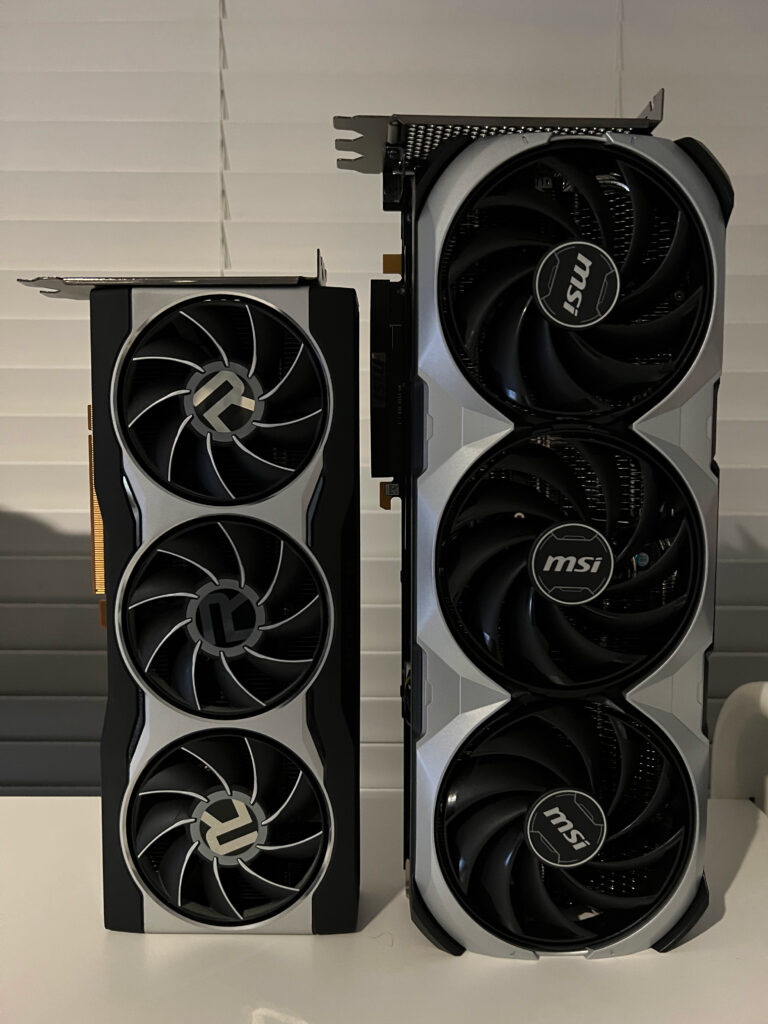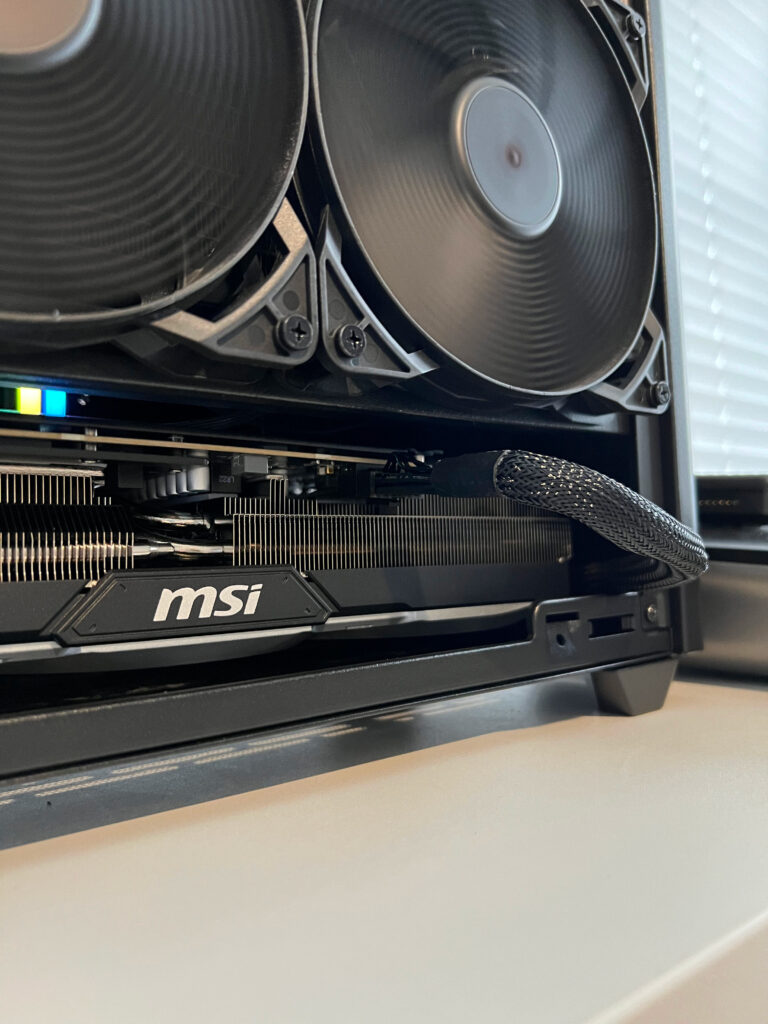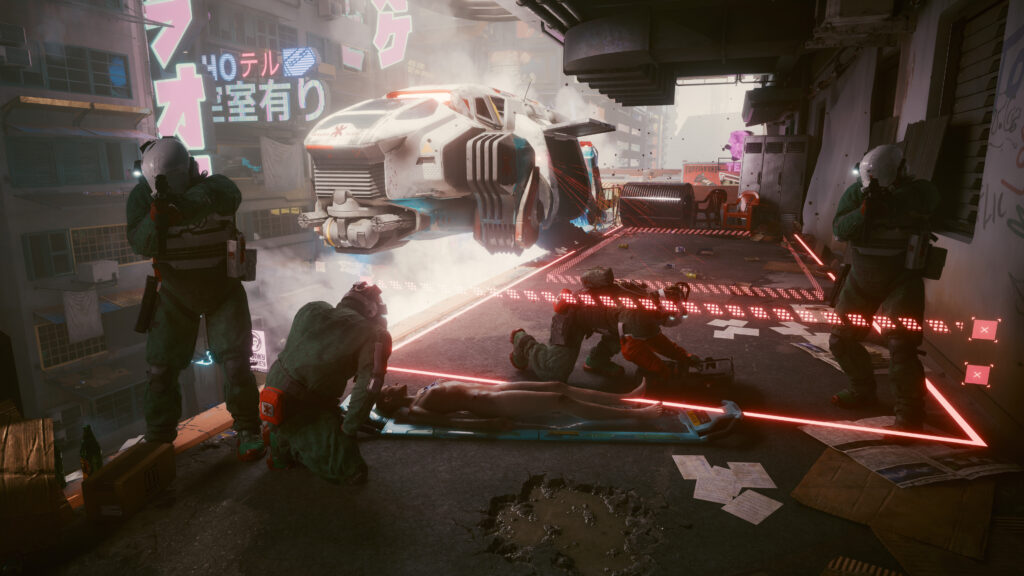The very best high-end PC hardware is often terrible value when comparing price to performance. I like to carefully read reviews and benchmarks before choosing something one or two steps down from the top, where a cheaper option can still provide sufficient performance for my needs. My current CPU Ryzen 7 5800X has 8 cores and 16 threads – more than enough for gaming and programming – while the best available at the time was 16 cores and 32 threads in the 5950X. My last GPU Radeon RX 6800 satisfied my requirement of being faster than the Playstation 5 (I just like to stay ahead of the consoles), and I didn’t have a 4K display yet so there was no need for the faster RX 6900 XTX or RTX 3080 Ti. This motherboard is B550 not X570, the RAM is only 3600 MHz, and the PCIe 4.0 NVMe SSD is just barely faster than PCIe 3.0 models. All of these were considered ‘good value’ at the time, and together they make a very adequate gaming PC.
But this time…
I want the best.
Last year I upgraded my display monitor from a Gigabyte G27Q 1440p/144Hz to Samsung Odyssey Neo G7 32 4K/165Hz. The old G27Q was very good for gaming in Standard Dynamic Range, but its promise of HDR was a lie with only 500 nits peak brightness and no backlight dimming to reach full black. I wanted real HDR and a larger size, and I’m not willing to play burn-in roulette with OLED, so I went with the next best thing: quantum dot LCD with mini LED local dimming. The HDR effect on the Neo G7 is stunning with 1000 nits peak brightness, although backlight bloom can be distracting in the expected scenarios like tiny bright stars against a black sky. Overall I’m very pleased with this display for 4K HDR games and movies. One small problem I noticed that isn’t mentioned on Samsung’s website or in the manual: the DisplayPort input and HDMI 1 can do 4K/165Hz, but HDMI 2 only does 4K/120Hz. This is fine.
RX 6800 was capable of running some less-demanding games at 4K. Forza Horizon 5, Marvel’s Spider-Man, and Doom Eternal can exceed 60fps with ray tracing enabled. but it struggled to run other modern games, and AMD’s FSR upscaling still produces inferior image quality compared to Nvidia’s DLSS or native resolution. This display demanded more power.
My first choice was going to be the Radeon RX 7900 XTX until user reviews complained about VR issues, higher than expected power usage, heat sink manufacturing problems, and a disappointing increase in ray tracing performance since the RX 6000 series. That left the RTX 4080 and RTX 4090 as my best options. RTX 4090 was 48% more expensive than RTX 4080 at actual local pricing (disregard MSRP), and for that I would receive 68% more compute cores and 50% more VRAM. The most expensive GPU is not supposed to be better value, yet here we are.
I could only find two models of air-cooled RTX 4090 that will physically fit inside my Cooler Master NR200P Mini-ITX case: Nvidia Founders Edition, and MSI Ventus 3X OC. Since the FE models are in short supply worldwide and basically not available in Australia, and the Ventus was on sale, it was an easy decision. Now I can’t close the case side because the new 12VHPWR power cable is sticking out from the side of the GPU until I find a suitable right-angle adapter.


How do I review the very best? Is there any point? Who is it for? It might be good value for professional 3D rendering in Blender, or machine learning models that need up to 24GB VRAM. It has an option to enable ECC memory mode, which I don’t care about. Right now I just want to play PC games at 4K HDR with Ray Tracing and all the graphics settings turned up to Ultra. So here’s how it performs in a selection of games at native resolution without upscaling. I have added percentages to show how the Nvidia GeForce RTX 4090 24GB compares to the GPU it’s replacing: AMD Radeon RX 6800 16GB. See my previous post for more details about the test system.
Some Games
Control
Preset High, Ray Tracing Preset High
| 1080p | 1440p | 4K | |
| RX 6800 | 61 fps | 40 fps | 19 fps |
| RTX 4090 | 133 fps (+118%) | 122 fps (+205%) | 64 fps (+236.8%) |
The Ascent
All Ultra, All Ray Tracing On
| 1080p | 1440p | 4K | |
| RX 6800 | 59 fps | 37 fps | 17 fps |
| RTX 4090 | 145 fps (+145.8%) | 121 fps (+227%) | 63 fps (+270.6%) |
Metro Exodus Enhanced Edition
Preset Extreme, Ray Tracing Ultra, Reflections Raytraced, VRS 2X, Hairworks On, Advanced PhysX On, Tessellation On, Shading Rate 1.0x
| 1080p | 1440p | 4K | |
| RX 6800 | 64 fps | 38 fps | 19 fps |
| RTX 4090 | 219 fps (+242.2%) | 159 fps (+318.4%) | 78 fps (+310.5%) |
Metro is the only game on this list where the 1440p increase percentage was higher than the 4K increase.
Hellblade: Senua’s Sacrifice
Preset Very High, RayTracing High
| 1080p | 1440p | 4K | |
| RX 6800 | 74 fps | 51 fps | 27 fps |
| RTX 4090 | 226 fps (+205.4%) | 170 fps (+233.3%) | 90 fps (+233.3%) |
Shadow of the Tomb Raider
Preset Highest, Ray Traced Shadow Quality Ultra, TAA
| 1080p | 1440p | 4K | |
| RX 6800 | 117 fps | 82 fps | 44 fps |
| RTX 4090 | 175 fps (+49.6%) | 165 fps (+101.2%) | 119 fps (+170.5%) |
Marvel’s Guardians of the Galaxy
Preset Ultra, Ray-Traced Reflections Ultra, Ray-Traced Transparent Reflections On
| 1080p | 1440p | 4K | |
| RX 6800 | 74 fps | 52 fps | 28 fps |
| RTX 4090 | 120 fps (+62.2%) | 119 fps (+128.8%) | 94 fps (+235.7%) |
Forza Horizon 5
Preset Ultra, TAA, Motion Blur Short
| 1080p | 1440p | 4K | |
| RX 6800 | 119 fps | 104 fps | 76 fps |
| RTX 4090 | 158 fps (+32.8%) | 152 fps (+46.2%) | 139 fps (+82.9%) |
Doom Eternal
Preset Ultra Nightmare, Raytracing On
| 1080p | 1440p | 4K | |
| RX 6800 | 184 fps | 136 fps | 71 fps |
| RTX 4090 | 440 fps (+139.1%) | 370 fps (+172.1%) | 238 fps (+235%) |
Marvel’s Spider-Man: Miles Morales
Preset Very High, TAA, Ray-Traced Reflections On, Ray-Traced Shadows High, Reflection Resolution High, Reflection Geometry Detail High, Object Range 6
| 1080p | 1440p | 4K | |
| RX 6800 | 101 fps | 96 fps | 64 fps |
| RTX 4090 | 88 fps (-12.9%) | 85 fps (-11.5%) | 85 fps (+32.8%) |
Definitely hitting a CPU bottleneck in Spider-Man, with RTX 4090 somehow performing worse than RX 6800 at 1080p and 1440p.
The Witcher 3 Enhanced
Preset RT, Hairworks On
| 1080p | 1440p | 4K | |
| RX 6800 | 49 fps | 37 fps | 20 fps |
| RTX 4090 | 101 fps (+106.1%) | 99 fps (+167.6%) | 57 fps (+185%) |
Cyberpunk 2077 (1.63)
Preset Ray Tracing: Ultra
Cyberpunk 2077 launched in December 2020 with three options for enhanced graphics with ray tracing: reflections, sun shadows, and lighting – but only on PCs with Nvidia RTX GPU. Patch 1.3 in March 2021 enabled ray tracing for PCs with AMD Radeon GPU. Patch 1.5 in February 2022 added a new ray tracing option local shadows which joined the existing options on PC, and became the first and only ray tracing available for this game on consoles (PS5 and Xbox Series X only).
The ‘Ray Tracing: Ultra’ preset on PC enables every ray tracing option.
| 1080p | 1440p | 4K | |
| RX 6800 | 33.20 fps | 21.00 fps | 9.66 fps |
| RTX 4090 | 81.70 fps (+146.1%) | 70.53 fps (+235.9%) | 39.59 fps (+309.8%) |
Cyberpunk 2077 (1.63) Overdrive
Preset Ray Tracing: Overdrive
Patch 1.62 in April 2023 added a new option for PC called Overdrive Mode. This replaces all previous ray tracing options with a single unified solution that applies physically-modeled lighting, shadow, and reflections to every surface in the game. Patch 1.63 in June improved performance.
I’m also testing this with upscaling using FSR or DLSS, as well as Frame Generation – a new feature only available on RTX 4000 GPUs which adds interpolated frames for smoother video at the cost of slightly worse input latency.
| 1080p | 1440p | 4K | |
| RX 6800 | 7.28 fps | – | – |
| RX 6800 (FSR Auto) | 15.25 fps | – | – |
| RTX 4090 | 63.41 fps | 41.66 fps | 20.67 |
| RTX 4090 (DLSS Auto) | 79.72 fps | 78.46 fps | 61.51 fps |
| RTX 4090 (DLSS Auto + FG) | 152.79 fps | 132.16 fps | 98.12 fps |




Conclusion
Excluding the Cyberpunk Overdrive results, in these selected games the RTX 4090 is 2.1x better at 1080p (+112%), 2.6x at 1440p (+166%), and 3x at 4K (+209%) compared to my old RX 6800.
This is awesome.
25 September update:
Overclocking
MSI 4090 Ventus 3X OC already comes with a small overclock compared the Nvidia 4090 Founders Edition, with the core boost clock raised from 2520 to 2550 MHz, or 2565 if you install MSI Center and enable Extreme Performance mode. I’m not doing that.
I installed MSI Afterburner and followed instructions from Reddit comments to adjust the power limit, temperature limit, and voltage sliders all the way to maximum. On this GPU the power limit slider cannot go higher than 100%, which enforces a maximum total GPU power limit of 450 Watts. Setting the voltage slider to +100% does not double the voltage (that would be very bad), instead it raises it from 1.05V to the maximum allowed 1.1V. Raising the temperature limit from the default 84C to 88C does little to help, since temperatures stayed below 80 in my testing.
I set the core clock offset to +200 MHz and gradually increased by 10 while running the Cyberpunk 2077 (2.0) benchmark at 4K with Path Tracing and DLSS 3.5 Quality, until it crashed at +270. Then I did the same for memory clock offset starting at +1000 MHz and increasing by 100, which crashed at +1700. For the Cyberpunk benchmark my best overclocking results were +260 core, +1600 memory.
To verify the stability of this overclock I ran the 3DMark Port Royal stress test. It was not stable. I had to step back down to +250 MHz core and +1500 MHz memory to pass the stress test. With these settings the frame rate in the Cyberpunk 2077 benchmark increased from 49.03 to 51.30 fps (without DLSS Frame Generation), an improvement of 4.6% from stock settings. Peak core frequency hit 3000 MHz (up from 2850 at stock) and peak memory frequency was 1469 MHz (up from 1281).
For comparison, the new ASUS 4090 Matrix Platinum (which costs approximately double the price of this MSI 4090 Ventus 3X OC) has a stock core boost speed of 2670 MHz. My stable overclock is 2800 MHz. Of course the Matrix has liquid cooling, liquid metal thermal interface material, and a power limit of 500 W so it will overclock higher. TechPowerUp was able to achieve an average core clock speed of 3061 MHz (9.3% higher than my overclock) and peak memory speed 1543 MHz (5% higher). I want to thank ASUS for making my budget 4090 look like excellent value.
